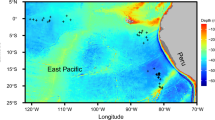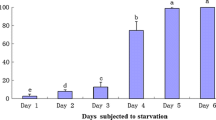Abstract
The aims of this study were to assess quantitatively the enzymatic ability of squid to digest lipids and the ability of the digestive gland to accumulate lipid classes associated with storage. This was achieved through two manipulative experiments using the dumpling squid, Euprymna tasmanica. Firstly, we measured lipase activity and determined the presence and location of lipid vacuoles within the digestive gland; secondly we identified and quantified lipid classes in the digestive gland. Given the levels of lipase activity, we provided evidence for the first time that a squid species is capable of digesting lipid at levels comparable to invertebrates known to use dietary lipid. A poor relationship between feeding activity and lipase secretion suggests that enzyme production is continuous. The second experiment found no evidence that lipid was stored in the digestive gland; most of the lipid present in the gland was either structural or a dietary by-product. The implication of these findings is that for this species lipid is most probably being immediately digested and used for growth and reproduction rather than being stored in the digestive gland. We consider that the role and storage of lipid is likely to vary among different cephalopod species, but not predictably as function of their lifestyle. Therefore, potential locations for lipid storage, other than the digestive gland, need to be considered and using changes in the relative size of the digestive gland as a measure of condition needs to be interpreted with care.


Similar content being viewed by others
References
Blanchier B, Boucaud-Camou E (1984) Lipids in the digestive gland and the gonad of immature and mature Sepia officinalis (Mollusca: Cephalopoda). Mar Biol 80:39–43
Bligh EG, Dyer WJ (1959) A rapid method of total lipid extraction and purification. J Biochem Physiol 37:911–917
Boucaud-Camou E, Boucher-Rodoni R (1983) Feeding and digestion in cephalopods. In: Boyle PR (eds) The mollusca. Academic, New York, pp 149–187
Boyle PR, Pierce GJ, Hastie LC (1995) Flexible reproductive strategies in the squid Loligo forbesi. Mar Biol 121:501–508
Bradford MM (1977) A rapid and sensitive method for the quantitation of microgram quantities of proteins utilising the principle of protein-dye binding. Anal Biochem 72:248–254
Castro BG, Garrido JL, Sotelo CG (1992) Changes in composition of digestive gland and mantle muscle of the cuttlefish Sepia officinalis during starvation. Mar Biol 114:11–20
Clarke A, Rodhouse PG, Gore DJ (1994) Biochemical composition in relation to the energetics of growth and sexual maturation in the ommastrephid squid Illex argentinus. Philos Trans R Soc Lond B 344:201–212
Eyster LS, Van Camp LM (2003) Extracellular lipid droplets in Idiosepius notoides, the southern pygmy squid. Biol Bull 205:47–53
Fox-Smith T (2002) Protein-nitrogen flux in the southern dumpling squid Euprymna tasmanica. BSc (Hons). School of Aquaculture, Australia
Gjellesvik DR, Lombardo D, Walther BT (1992) Pancreatic bile salt dependent lipase from cod (Gadus morhua): purification and properties. Biochim Biophys Acta 1124:123–134
Hammer HS, Bishop C, Watts S (2000) Activities of three digestive enzymes during development in the crayfish Procambarus clarkii (Decapoda). J Crust Biol 20:614–620
Hayes JP, Shonkwiler JS (2001) Morphometric indicators of body condition: worthwhile or wish thinking? In: Speakman JR (ed) Body composition analysis of animals: a handbook of non-destructive methods. Cambridge University Press, Cambridge, pp 8–38
Jackson GD, Mladenov PV (1994) Terminal spawning in the deepwater squid Moroteuthis ingens (Cephalopoda: Onychoteuthidae). J Zool Lond 234:189–201
Jackson GD, Semmens JM, Phillips KL, Jackson CH (2004) Reproduction in the deepwater squid Moroteuthis ingens, what does it cost? Mar Biol 145:905–916
Johnston DJ (2003) Ontogenetic changes in digestive enzymology of the spiny lobster, Jasus edwardsii Hutton (Decapoda, Palinuridae). Mar Biol 143:1071–1082
Johnston DJ, Freeman J (2006) Dietary preference and digestive enzyme activities as indicators of trophic resource utilization by six species of crab. Biol Bull (in press)
Johnston DJ, Yellowlees D (1998) Relationship between dietary preferences and digestive enzyme complement of the slipper lobster Thenus orientalis (Decapoda: Scyllaridae). J Crust Biol 18:126–135
Johnston DJ, Hermans JM, Yellowlees D (1995) Isolation and characterisation of a trypsin from the slipper lobster Thenus orientalis. Lund Archiv Biochem Biophys 324:35–40
Johnston D, Moltschaniwskyj N, Wells J (2006) Development of the radula and digestive system of juvenile blacklip abalone (Haliotis rubra): potential factors responsible for variable weaning success on artificial diets. Aquaculture (in press)
Kunitz M (1947) Crysalline soybean trypsin inhibitor: II. General properties. J Gen Physiol 30:291–310
Lee PG, Blake NJ, Rodrick GE (1980) A quantitative analysis of digestive enzymes for the freshwater prawn Macrobrachium rosenbergii. Proc World Maricult Soc 11:392–402
Lee PG, Smith LL, Lawrence AL (1984) Digestive proteases of Penaeus vannamei Boone: relationship between enzyme activity, size and diet. Aquaculture 42:225–239
Lehninger AL (1987) Lipids and membranes. In: Lehninger AL (ed) Principles of biochemistry. Worth Publishers, New York, pp 303–329
Moltschaniwskyj NA (1995) Changes in shape associated with growth in the loliginid squid Photololigo sp.: a morphometric approach. Can J Zool 73:1335–1343
Moltschaniwskyj NA, Semmens JM (2000) Limited use of stored energy reserves for reproduction by the tropical loliginid squid Photololigo sp. J Zool Lond 251:307–313
Mommensen TP, Hochachka PW (1981) Respiratory and enzymatic properties of squid heart mitochondria. Eur J Biochem 120:345–350
O’Dor RK, Mangold K, Boucher-Rodoni R, Wells MJ, Wells J (1984) Nutrient absorption, storage and remobilization in Octopus vulgaris. Mar Behav Physiol 11:239–258
Pecl G (2001) Flexible reproductive strategies in tropical and temperate Sepioteuthis squids. Mar Biol 138:93–101
Phillips KL, Nichols PD, Jackson GD (2003) Size-related dietary changes observed in the squid Moroteuthis ingens at the Falkland Islands: stomach contents and fatty-acid analyses. Polar Biol 26:474–485
Rodriguez A, Le Vay L, Mourente G, Jones DA (1994) Biochemical composition and digestive enzyme activity in larvae and postlarvae of Penaeus japonicus during herbivorous and carnivorous feeding. Mar Biol 118:45–51
Rosa R, Costa PR, Pereira J, Nunes ML (2004a) Biochemical dynamics of spermatogenesis and oogenesis in Eledone cirrhosa and Eledone moschata (Cephalopoda: Octopoda). Comp Biochem Physiol B 139:299–310
Rosa R, Costa PR, Nunes ML (2004b) Effect of sexual maturation on the tissue biochemical composition of Octopus vulgaris and O. defilippi (Mollusca: Cephalopoda). Mar Biol 145:563–574
Rosa R, Pereira J, Nunes ML (2005a) Biochemical composition of cephalopods with different life strategies, with special reference to a giant squid, Architeuthis sp. Mar Biol 146:739–751
Rosa R, Costa PR, Bandarra N, Nunes ML (2005b) Changes in biochemical composition and energy reserves associated with sexual maturation in the ommastrephid squids Illex coindetii and Todaropsis eblanae. Biol Bull 208:100–113
Semmens JM (1998) An examination of the role of the digestive gland of two loliginid squids, with respect to lipid: storage or excretion? Proc R Soc Lond B 265:1685–1690
Semmens JM (2002) Changes in the digestive gland of the loliginid squid Sepioteuthis lessoniana (Lesson 1830) associated with feeding. J Exp Mar Biol Ecol 274:19–39
Semmens JM, Moltschaniwskyj NA, Alexander CG (1995) Effect of feeding on the structure and function of the digestive gland of the tropical sepioid Idiosepius pygmaeus. J Mar Biol Assoc UK 75:885–897
Swift K, Johnston DJ, Moltschaniwskyj N (2005) The digestive gland of the southern dumpling squid (Euprymna tasmanica): structure and function. J Exp Mar Biol Ecol 315:177–186
Tocher DR (2003) Metabolism and functions of lipids and fatty acids in teleost fish. Rev Fish Sci 11:107–184
Walter HE (1984) Proteinases: methods with hemoglobin, casein and azocoll as substrates. In: Bergmeyer HU (ed) Methods of enzymatic analysis. Verlag Chemie, Weinheim, pp 270–277
Wigglesworth JM, Griffith DRW (1994) Carbohydrate digestion in Penaeus monodon. Mar Biol 120:571–578
Acknowledgements
This project was funded by the University Internal Research Grant Scheme. We thank D. Sinn and T. Fox-Smith for assistance in collection of animals, and K. Swift for assistance in the experiments. Collection, handling and killing procedures cleared by University of Tasmania Animal Ethics Committee, Permit #A0006998.
Author information
Authors and Affiliations
Corresponding author
Additional information
Communicated by M.S. Johnson, Crawley
Rights and permissions
About this article
Cite this article
Moltschaniwskyj, N., Johnston, D. Evidence that lipid can be digested by the dumpling squid Euprymna tasmanica, but is not stored in the digestive gland. Mar Biol 149, 565–572 (2006). https://doi.org/10.1007/s00227-006-0246-z
Received:
Accepted:
Published:
Issue Date:
DOI: https://doi.org/10.1007/s00227-006-0246-z




